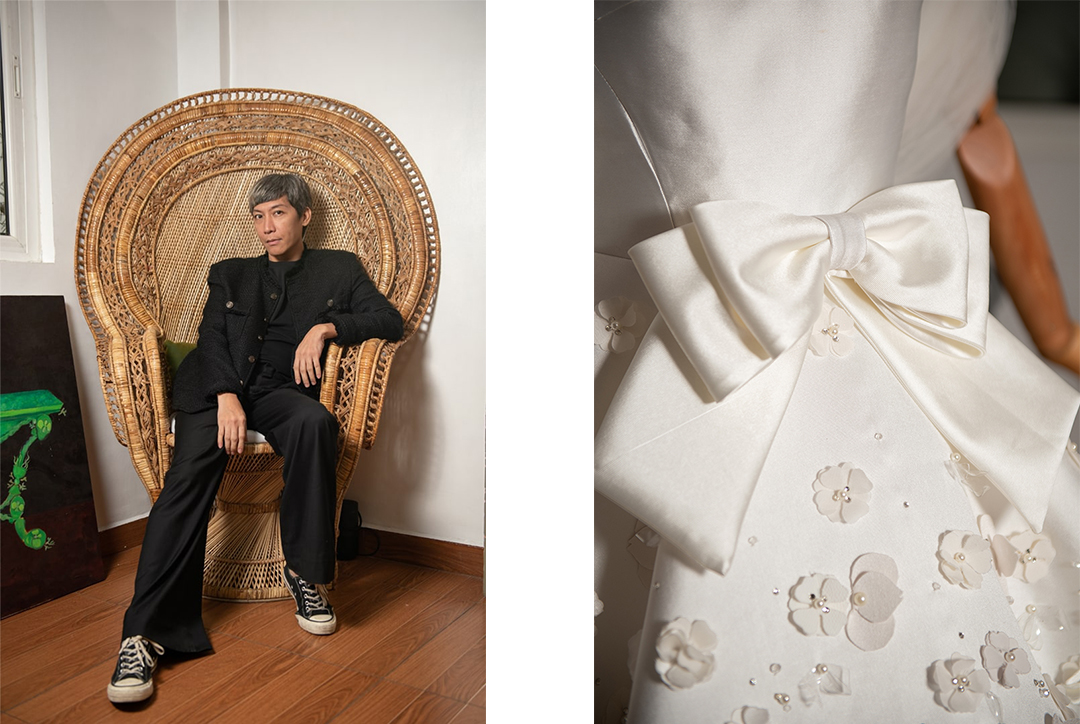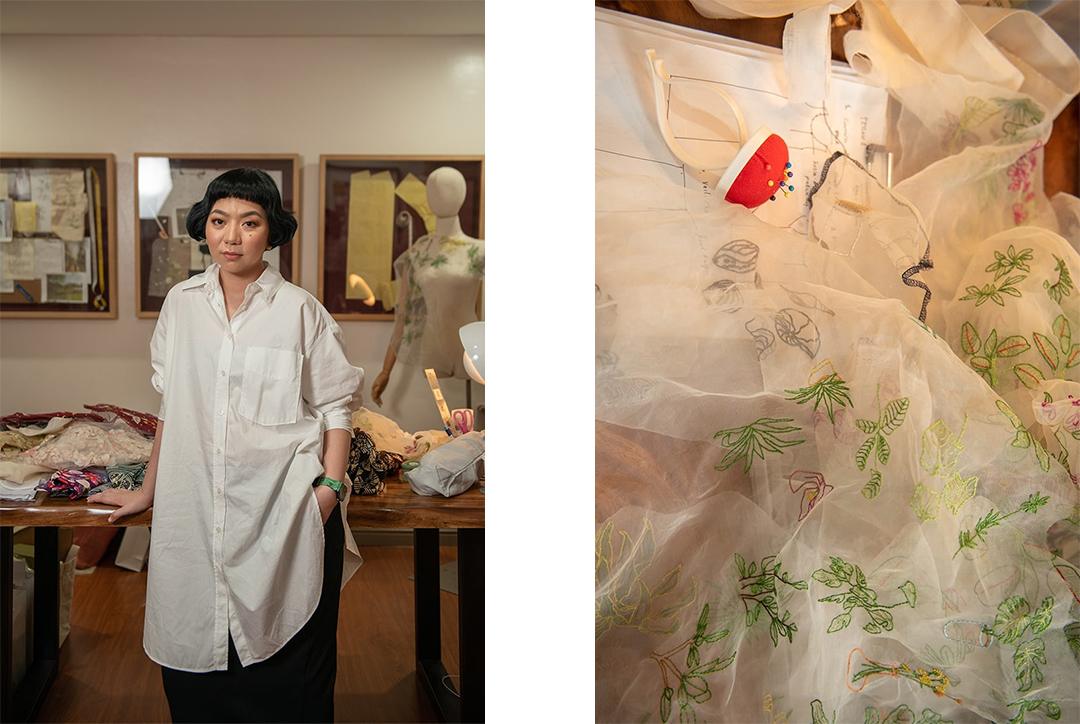What does it really take to be sustainable in the fashion industry?
This is story is from MEGA’s November 2022 issue.
Sustainability has become a weighted word—with equally heavy responsibilities at that—in all industries’ economical and environmental aspects, including fashion’s. With this societal goal spreading like wildfire, spanning years, how do we prevent it from being reduced to the fleeting nature of trends?
There’s a price for everything, even with the dream of harmoniously co-existing with our own world. Luckily, the local fashion front has been shifting its focus towards processes and practices that forward conscious production above all else.
RELATED: 5 Local Designers Who Rework Clothing As A Response To Sustainability
Meet the designers who will change the way we perceive fashion through the lens of sustainability.
NERIC BELTRAN

For designer Neric Beltran, sustainability in fashion is a constant and conscious effort in producing or making lasting quality garments. Aside from choosing the right materials and the best practices, it’s also about taking care of the people working behind the production line.
“It should tap all aspects of production such as paying the work staff the proper amount or value for their work,” says Beltran. “[From] giving them a schedule that allows them to balance their work and home or personal life to picking and using materials that are recyclable or made with natural components. Practicing, developing, and sharing artisanal or handmade techniques such as hand embroidery and sewing is also part of our process—creating sustainable garments and letting our clientele know that it is made sustainably to be able to raise awareness.”
Producing a great amount of waste material when making clothes is almost inevitable, and so Beltran, with the creative mind and sterling craftsmanship he holds, knew that something can be made out of the excess. The designer then offered services to his clients by creating pieces that included fabric scraps or deadstock materials. He also encourages them to bring existing clothes from their wardrobe so he can rework them into new ones instead of buying new material. This way, Beltran believes he is able to share with them the value of sustainability: It does not always have to be made from new fabrics.

“The true cost of sustainability is climate emergency, which most of us do not take seriously,” the seasoned designer explains, putting the spotlight on the crucial role of the environment in all working industries. “It affects all of us—we just fail to recognize it. And because we continuously chase trends, we always opt for fast fashion. In effect, we contribute more to environmental damage.”
Although Beltran admits that they are not yet a fully sustainable brand, he shares that having access to the technology and advanced practices that other countries have in producing sustainable materials would help them—and any other fashion house—improve their services. For now, whatever they can do to contribute in reducing fashion waste will be their advocacy, a core value they will always promote and practice.
“It’s a continuous journey,” Beltran says. “More things to learn and discover. My vision for Philippine fashion is for us to have advanced knowledge that are at par with what other countries have so we may be able to participate in the global fashion stage. It’s also important to produce jobs that compensate our workers fairly and that they may be recognized as important and valuable contributors to sustainable fashion practices.”
GABBIE SARENAS

Championing Philippine artisanship and techniques, designer Gabbie Sarenas dedicates her days to immortalizing local tradition through fashion and lifestyle. With whimsical and nostalgic hand work, Sarenas’ passion for textiles and embroidery tells the unique story of Filipino heritage.
“For me, sustainability encompasses different areas of the fashion industry,” the MEGA Magazine 2019 NewPH Awardee explains. “Not just with the choice of material but also with your activities and process, most especially. In addition to reducing your carbon footprint, it’s what you can do to sustain your heritage and the lessons of your country—in my case, it’s always been the sustainability of the work of the human hands.”
Sarenas’ eponymous brand anchors itself on the work of the human hands and Philippine culture. It can’t just be making clothes left and right. There has to be substance and a goal that every piece can be worn in a variety of ways by the consumer and, hopefully, to be passed on. Apart from the consistent push of hand work (through the use of pina and hand embroidery), Sarenas and her team are constantly learning the basics of making quality products. With going back to basics, they believe that they are building a strong foundation not just for themselves, but also for their clients.

“The cost can get quite high not just with the materials, but [also] with labor,” says Sarenas when asked what the true cost of sustainability is. “All the more that you have to spend on labor because the creative human hands made the golden eggs. Another is that the process can be more tedious so we can’t exactly make quick products on a whim. By experience, it does take time not only with production, but also with the entire research and development process from start to finish.”
The ultimate dream of Sarenas? A self-sustaining industry wherein they get all their materials locally. Although unsure of how it will fare as she is more of a creative than a business-minded person, all she knows now is that they have to consistently work and make sure that each piece is better than the last. Sarenas firmly holds that this is the first step towards her goal for Philippine fashion.
LULU TAN-GAN

“The word ‘sustainability’ in the context of fashion refers to the environmental impacts of making—from processing and manufacture of raw materials to fabric to finished product,” explains the hailed “Queen of Knitwear” Lulu Tan-Gan. “There must be a balanced use of natural, organic, and recyclable synthetic. Some natural materials might require cutting down more trees and require more energy to produce. Sustainable or green fashion promotes a circular system to lower waste levels, uses eco-friendly fabrics to reduce its environmental impact, improves the worker conditions of mass fashion brands, and promotes an attitude of careful consumption.”
As a designer, Tan-Gan proclaims that sustainability starts with a decision to keep one’s brand eco-friendly. Since they started producing pieces in the mid-80s, they make their materials only by hand loom as they were into hand loom knitwear. Then in the late 2000s, they extended to use hand loom weave to produce their designs. As a way of giving back and hoping to influence Filipino design, they chose the indigenous and eco-friendly pinya as fiber. Designs are also consciously created, using flat patterns that can be waste-free.

“Mindless designs can cause a lot of wastage,” Tan-Gan points out. “From forced labor tales to stories of monstrous levels of carbon emissions, fashion’s struggle with sustainability is known. However, the fast growing sustainable fashion sector has modeled itself to represent a kinder and greener future.”
Tan-Gan acknowledges that the downside of sustainable fashion is that it’s pricey. However, it also often equates to higher quality. As the designer explains it, while one may hand over more money in the short term of creating a sustainable wardrobe, money is saved in the long run because clothes last longer. Simply put, replacing a PHP 1,000 dress every six months soon starts costing more than paying PHP 8,000 for a dress that lasts 10 years. Tan-Gan also notes that extending the life of a garment by just nine months can already reduce its carbon footprint by 20% to 30%.
When asked what her vision for Philippine fashion is through the lens of sustainability, Tan-Gan answers that it’s all about the mindful choice of materials and design innovation. “For a sustainable fashion system to work, it needs to be supported at all levels,” says the former President of the Fashion and Design Council of the Philippines. “Brands need to be genuinely committed to changing their production process. Governments need to implement policies and enforce companies to comply. The public needs to be willing to choose to buy from sustainable brands, even if that means changing the way we shop.”







